Stories of real people the Environmental Integrity Project has helped through our work.
Clean Drinking Water for a Rural Texas Town
For decades, Berta and Oscar Chapa Jr. and their 600 neighbors in the remote south Texas town of Bruni have had to endure an ordeal just to drink water.
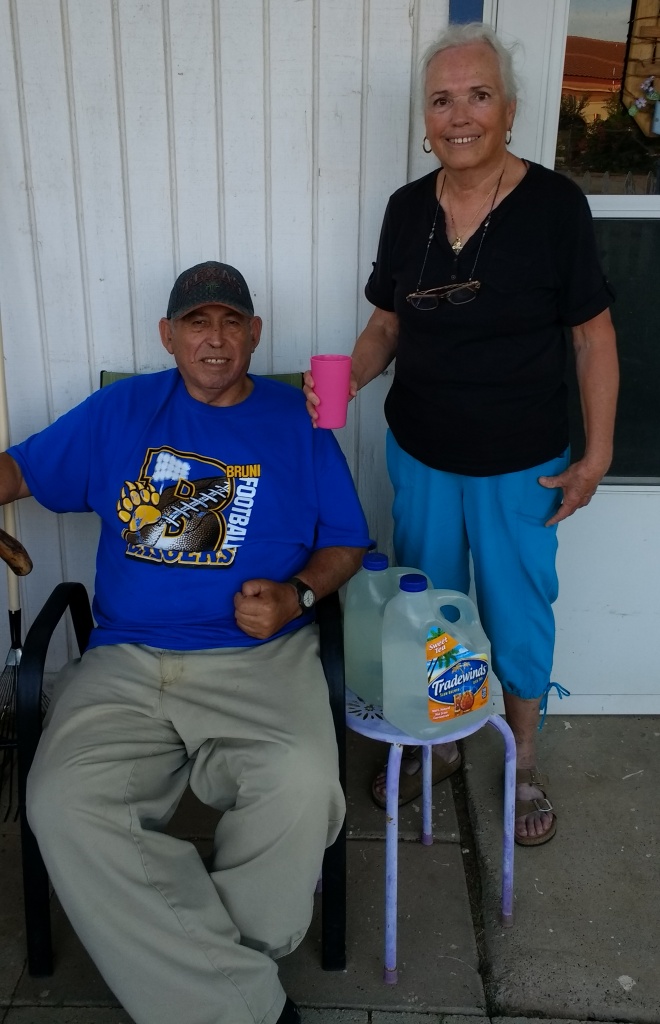 Once a week, Berta, a 76-year-old grandmother, and Oscar, a 75-year-old former oilfield worker disabled by injury, drive 13 miles to a nearby town, Hebbronville, to fill up 20 gallon-sized containers with water. As Oscar watches from the car, unable to help with the lifting, Berta fills up the buckets from a water dispensing machine. Then she lugs them back to their car so they can drive home and line them up on the floor of their laundry room.
Once a week, Berta, a 76-year-old grandmother, and Oscar, a 75-year-old former oilfield worker disabled by injury, drive 13 miles to a nearby town, Hebbronville, to fill up 20 gallon-sized containers with water. As Oscar watches from the car, unable to help with the lifting, Berta fills up the buckets from a water dispensing machine. Then she lugs them back to their car so they can drive home and line them up on the floor of their laundry room.
This is their only way to get clean water for drinking and cooking. For years, the tap water in their home has had more than eight times the legal limit of arsenic, a cancer-causing element from the soil that may also contribute to heart diseases and loss of IQ among children.
In fact, Bruni’s public drinking water system has the highest levels of arsenic in Texas, according to a March 2016 report by the Environmental Integrity Project (EIP) titled, “Don’t Drink the Water.”
The report, which was inspired by the drinking water crisis in Flint, Michigan, examined state records and found 51,000 people in 34 towns across Texas – many isolated, rural, Latino communities like Bruni – with arsenic in their drinking water for at least a decade at concentrations above the health limits set by the Safe Drinking Water Act. Worse yet, neither Texas nor local water utilities have been adequately warning these residents about the contaminated water.
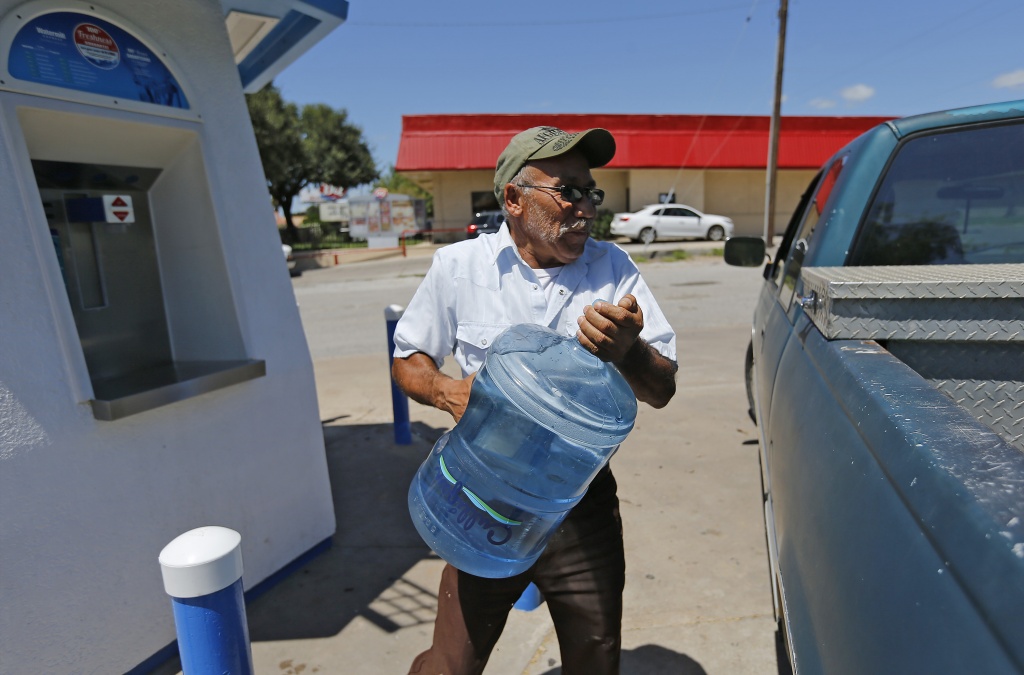
The publication of EIP’s report triggered more than 130 news reports across the state, including in the San Antonio Express News, Austin Statesman American, Dallas Morning News and on the NBC affiliate in Houston, KPRC-TV. And it also sparked real change for the people of Bruni.
After reading stories based on the EIP report in the San Antonio Express News and Texas Tribune, U.S. Rep. Henry Cuellar, a Democrat from Laredo who represents the people of Bruni, pushed the U.S. Department of Agriculture and the local county government to come up with $2 million to build a water filtration plant to remove the arsenic and solve the water contamination problem for Bruni.
“I would like to thank the Environmental Integrity Project for helping draw the attention needed to this important issue,” Oscar Chapa Jr. said. “Over the years our town had become accustomed to the limited uses for our contaminated water supply. Now, thanks to the new water filtration plant, my grandchildren and our community will have clean water and a healthier quality of life.”
The new water filtration plant should be constructed in about two years, and allow the families in Bruni to finally drink from the water in their own homes.
“I think the story just motivated everybody,” Congressman Cuellar said of the news article he read in the San Antonio Express News that used EIP’s report for its numbers.
“Congratulations for the EIP spurring some action in at least this small corner of Texas, though I’m sure the effects of that report are still reverberating,” said Brendan Gibbons, Environment and Water reporter for the San Antonio Express-News.
Following up on the Texas report, EIP continues to investigate drinking water contamination issues elsewhere in the U.S.
Examining California state records, the organization found that 95 community water systems serving more than 55,000 people have been providing tap water with illegal levels of arsenic for at least the last two years, while failing to warn people not to drink the water.
That report, “Arsenic in California Drinking Water,” – like the Texas report – urged the federal and state governments to invest more money in water filtration systems and provide clearer advisories to the public.
As a result of the Texas and California reports, the U.S. House Energy and Commerce Committee invited EIP Executive Director Eric Schaeffer and other experts to brief the committee’s staff on ways to improve the safety of the public drinking water systems nationally.
On September 23, 2016, U.S. Representatives Frank Pallone Jr. (D-NJ) and Paul Tonko (D-NY) introduced a bill called the Safe Drinking Water Act Amendments of 2016 that is intended to increase federal investments in clean drinking water nationwide and improve public reporting requirements about contamination.
But back in Bruni, Texas, Oscar Chapa is just happy that his grandchildren and great-grandchildren will finally be able to drink the water in their own homes.
Student Stops the Biggest Trash-Burning Incinerator in America, with EIP’s Help
 When she was just 16 years old, Destiny Watford decided to take on Maryland’s entire political establishment over a development project proposed near her neighborhood in Baltimore’s Curtis Bay.
When she was just 16 years old, Destiny Watford decided to take on Maryland’s entire political establishment over a development project proposed near her neighborhood in Baltimore’s Curtis Bay.
A New York-based company called Energy Answers was proposing to build America’s biggest trash-burning incinerator in Fairfield, not far from her high school. The project would generate electricity by burning shredded garbage. But it would also add large amounts of air pollution in a working-class community already burdened with some of the worst air pollution in the state, not to mention coal plants, a sewage plant, chemical factories, and coal dust from an export terminal.
The developers had almost everyone on their side, including Governor Martin O’Malley and Mayor Stephanie Rawlings Blake. Local governments and even the Baltimore city school system had signed contracts to purchase power from the incinerator.
But the project did not have Destiny on its side. “We decided that it isn’t the fate of our community or our planet to be a dumping ground,” she said.
She and a group of her fellow students at Benjamin Franklin High School formed an organization called Free Your Voice to fight the incinerator. And over a period of four years, they held marches and protests and met with all of the local leaders who would listen to them.
The coalition was assisted by the Environmental Integrity Project, which provided the legal and technical muscle to back up the community organizing. EIP attorney Leah Kelly provided free legal services, scrutinizing and challenging the federal Clean Air Act Permit for the proposed incinerator. Kelly also worked with EIP’s team of analysts to study and document the air pollution in the neighborhood.
In the end, Watford’s activism with allies, including the Baltimore human rights group United Workers, succeeded in convincing Baltimore area governments to cancel their energy-purchase contracts with the developer. That dealt a financial blow to the project.
And Kelly’s legal work – which included a notice of intent to sue the developer in February 2016 – led to a March 17, 2016, decision by the Maryland Department of the Environment terminating the Clean Air Act permit to construct the project, which effectively drove a stake into its heart.
On April 18, 2016, Watford received an international award for environmental heroism in leading the fight for her neighborhood: the prestigious Goldman Environmental Prize.
“I’m from Baltimore, a place that is on the front lines of many injustices – from police brutality, to racial discrimination, economic inequality and environmental injustice,” Watford, now a student at Towson University, said at the Goldman Prize awards ceremony in San Francisco.
She expressed outrage that the political system had betrayed her neighborhood, in ways including a backward system of energy subsidies that rewards trash incineration as “clean energy.”
“The fact that legally, in my state, burning trash is considered a renewable energy source to receive public subsidies for climate solutions like wind and solar is a clear sign that our system is failing us and our planet,” Watford said.
In a post on their Facebook site, Watford’s group, Free Your Voice, voiced their thanks to EIP. “Powerful light shining on the work to stop the incinerator made possible by our collaboration with so many including the Environmental Integrity Project and the expert legal work by Leah Kelly. The diversity of strengths we were able to bring to the table – from arts and media to legal expertise – was critical in being able to lead past the environmental injustice of the incinerator towards positive fair development alternatives.”
Now, Watford and allies are trying to organize a healthier type of development on the vacant site – perhaps a community-owned solar farm.
Having won the international prize, Watford is determined to keep fighting for a cleaner and healthier Baltimore. And EIP will be there to lend a hand, if needed, to her and others fighting similar battles for environmental justice.
Shutting Down America’s Biggest Coal Ash Waste Pond
 Years ago, there was a wooded valley with a stream running through it in Chester, West Virginia.
Years ago, there was a wooded valley with a stream running through it in Chester, West Virginia.
Curt Havens, an assistant post master in the rural community, and his wife, Debbie, built their home and their life next to that hollow. They were raising two sons, enjoying their gardening – when one day a man came by, flashed a brochure and told them the good news. A manmade lake would be built in the valley, and all the neighbors could enjoy it for boating, fishing, and sunbathing.
The man worked for the power company, and the catch was this: His utility would also use the lake, but for something else – disposing of ash from a coal fired power plant several miles away in Shippingport, Pa. But he assured them the unusual arrangement would work – as the ash would be harmless and form a cement-like bottom for the pool.
“They said it was going to be like a resort area, where you could hike, bike, and picnic,” Debbie Havens, now 64, recalls. “But it was a total lie.”
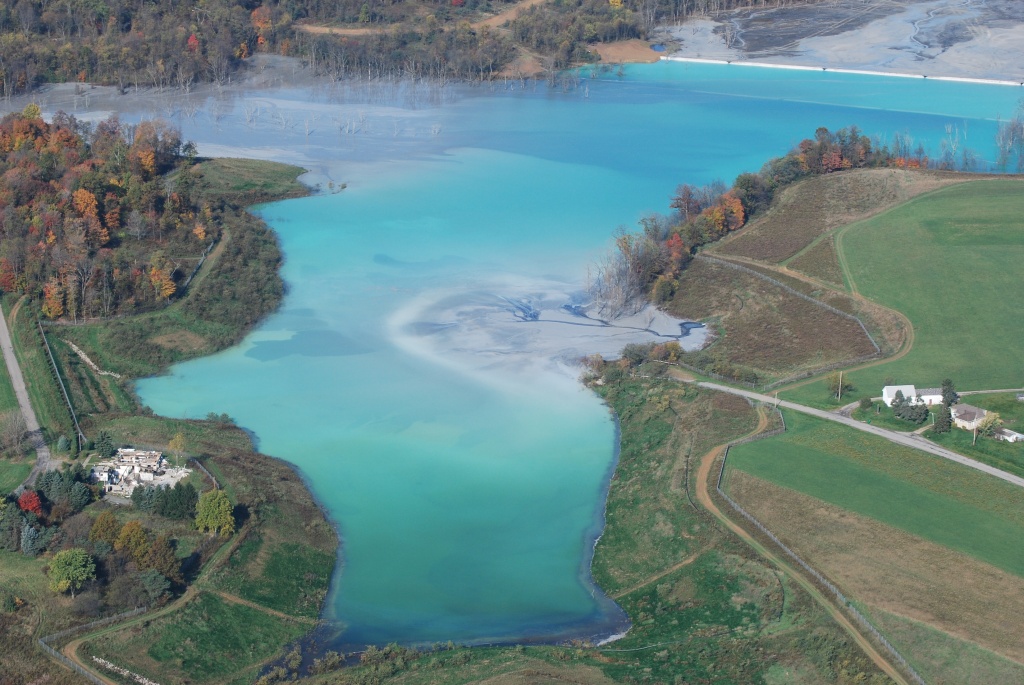 What really happened was this: The power company, FirstEnergy, inserted a pipe into the wooded valley and pumped in so many millions of gallons of toxic coal ash slurry that a foul-smelling waste pond formed. The waste dump – nicknamed “Little Blue” – grew until it was 2.5 miles across, the largest coal ash waste impoundment in the U.S. And because it was unlined, Little Blue began to leak, releasing trickles of odorous sludge into nearby yards, destabilizing the foundations of homes, causing mold to flourish everywhere, and making the Havens afraid to eat from their garden because of all the dust.
What really happened was this: The power company, FirstEnergy, inserted a pipe into the wooded valley and pumped in so many millions of gallons of toxic coal ash slurry that a foul-smelling waste pond formed. The waste dump – nicknamed “Little Blue” – grew until it was 2.5 miles across, the largest coal ash waste impoundment in the U.S. And because it was unlined, Little Blue began to leak, releasing trickles of odorous sludge into nearby yards, destabilizing the foundations of homes, causing mold to flourish everywhere, and making the Havens afraid to eat from their garden because of all the dust.
“When the odors come through our home in the middle of the night, it wakes me up, it’s so bad,” said Debbie Havens, who said the rotten-egg odors aggravates her asthma. “Sometimes I would actually take my pillow and blanket and go into my walk-in closet and sleep in there, because there are no vents in there.”
Curt Havens developed thyroid cancer, as did several of his neighbors who live around the ash dump – although the cause is unclear.
Fed up, the Havens took action to stop the pollution with the help of the Environmental Integrity Project (EIP). In May 2012, EIP filed a notice of intent to sue First Energy on behalf of the Havens and a coalition of neighbors they lead called the Little Blue Regional Action Group. The action resulted in an intervention by the Pennsylvania Department of Environmental Protection and consent decree that will force the power company to close and cover the pond, pay an $800,000 penalty, and take responsibility for cleaning up the mess.
Watch this Earthjustice-produced video on the actions against FirstEnergy at Little Blue, featuring Lisa Graves-Marcucci.
“We feel that it was a real victory, because nobody had ever challenged the power company before,” said Curt Havens, 67, who praised the work of EIP’s Lisa Graves-Marcucci and Lisa Widawsky Hallowell. “Without them, we would still be sitting here, twiddling our thumbs, trying to figure out what do to.”
Debbie Havens agreed: “We love them, we love them – and couldn’t have done it without them. It was just us ordinary people up against this giant.”
Curt Havens was so inspired by the fight to protect his neighborhood that he worked with EIP to travel to Washington D.C. and testify before EPA and a U.S. House subcommittee in favor of national regulations to stop pollution from coal ash dumps nationally.
He didn’t want the same kind of damage to destroy the lives of any more families across the country.
His efforts – and those of EIP and several other allied environmental groups – was somewhat fruitful. In 2015, EPA imposed the nation’s first national coal ash regulations, which – while not as strong as many had hoped – require more protections of groundwater and monitoring, and the closure of some coal ash ponds like Little Blue.
“We don’t want anybody else to go through the hell that we have,” said Debbie Havens.
Protecting a Family’s Heritage from Coal Ash Groundwater Contamination
To help illustrate the human impacts of toxic coal ash pollution, EIP profiled a south Texas ranching family as part of its report, “Groundwater Contamination from Texas Coal Ash Dumps.”
Decades ago, the Peelers leased a central part of their 25,000 acres of ranchland to the San Miguel Electric Co-Op to build a coal-fired power plant. Over the years, coal ash—the toxic byproduct of burning coal—was stored on and transported across their land. During this time, the Peelers watched apprehensively as the impacts piled up; literally in the form of ash mounds, and figuratively as pastures around the ash sites withered and fish died off in nearby ponds.
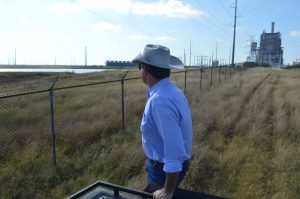
Jason Peeler looks out at the coal ash dump and coal-fired power plant on his ranch. His family believes contaminants leaking from the coal ash waste pond behind the fence are poisoning groundwater and killing vegetation. “It’s like losing a family member,” Peeler said of the family’s fears that they could lose their ranch.
Thanks to a new requirement in federal coal ash regulations, 16 of Texas’s power plants were required to report on coal ash contamination for the first time in 2018. All were found to be leaching unsafe levels of arsenic, cobalt, lithium, and other pollutants into the groundwater, with the San Miguel power plant exhibiting the worst pollution of all.
Currently engaged in a legal battle with the utility, the Peelers hope to force the operator to restore the land to its original condition. Meanwhile, San Miguel has threatened to use eminent domain to condemn the land and take it over if an agreement in their favor can’t be reached.
The Peeler’s story was picked up by news outlets across Texas, including the Texas Tribune, The San Antonio New-Express, the Texas Observer, and many other local outlets. The Longview News-Journal wrote an editorial about it EIP’s analysis, saying “No matter your political persuasion, you cannot ignore the findings of this report.”
NBC’s local news affiliate covered the report and visited the Peeler’s ranch, and made a commitment to continue pursuing the story as it develops.
This attention will hopefully help the Peelers in the months and years ahead as they take on the deeply entrenched and deep-pocketed fossil fuel industry. Not only are they fighting to reclaim their land to a healthy state, but also to make sure the coal ash groundwater pollution doesn’t spread further, potentially contaminating nearby rivers and sources of drinking water.
“Thanks to the Environmental Integrity Project for shining a spotlight on this issue,” said Jason Peeler, a fourth generation cattle rancher. “Their analysis of the groundwater monitoring data on our ranch, and in-depth report examining the problem of leaking coal ash dumps across Texas, is helping our family to fight back against this pollution and save our land and heritage.”
The Peeler’s plight is just one example of hundreds of local impacts across the country as policymakers and regulators begin to grapple with coal ash’s toxic legacy. After decades of dumping the byproduct in poorly lined or unlined pits bordering important ecological areas and sources of drinking water, it’s high time the issue received the attention it deserves. The new data available thanks to the federal Coal Ash Rule and the willingness of those impacted to speak out makes this possible.
Landmark Victory for Clean Water In Chesapeake Bay’s Biggest Tributary
In July 2019, EIP reached a historic agreement to reduce toxic pollutants leaking from a Pennsylvania power plant’s coal ash dumps into groundwater and the Susquehanna River, the largest Chesapeake Bay tributary. The agreement requires Talen Energy, owner of the Brunner Island Generating Station in York Haven, to pay a $1 million civil penalty – the largest penalty for coal ash pollution in the state’s history.

Lower Susquehanna Riverkeeper Ted Evgeniadis outside the Brunner Island power plant.
EIP represented the Lower Susquehanna Riverkeeper Association, Waterkeeper Alliance, and PennEnvironment in an August 28, 2018, notice of intent to sue Talen Energy for violating the Clean Water Act, which triggered the involvement of the Pennsylvania Department of Environmental Protection (DEP) to reach the historic settlement agreement. The agreement also requires Talen Energy to close and excavate one ash pond, monitor and address leakage of pollutants from other waste sites, and contribute $100,000 to fund supplemental projects to reduce local water pollution.
Ted Evgeniadis, the Lower Susquehanna Riverkeeper, worked closely with EIP’s staff throughout the process and was critical in achieving the momentous outcome.
“Thanks to the skillful work of the attorneys at the Environmental Integrity Project, our organization was able to achieve a landmark victory for clean water in the Chesapeake Bay’s biggest tributary,” said Evgeniadis. “Our grassroots organization detected high levels of toxic heavy metals leaching from Brunner Island’s unlined coal ash dump, and rallied local support for the cleanup of the leaky waste site. But the Environmental Integrity Project’s knowledge of the federal Clean Water Act – and the fact that they have top level, former EPA enforcement attorneys on staff – provided the legal muscle to help our community organization achieve our goals in cleaning up coal ash from the Susquehanna River.”
The Brunner Island coal-fired power plant, which opened in 1961, creates 442,000 tons of ash and other coal combustion wastes annually. For years, the company has disposed of coal ash waste in seven unlined ponds and a lined landfill that cover a combined 367 acres on an island bordered on the east the Susquehanna River and on the west by tributaries called Black Gut Creek and by Conewago Creek.
Because most of the ash sites are often saturated with groundwater and lack liners to prevent leakage, pollutants – including arsenic (a carcinogen), boron (which can cause nausea and vomiting), and lithium – have been seeping into groundwater, the Susquehanna River, and Black Gut Creek.
“The agreement will reduce the impact of toxic coal ash pollution on ground and surface waters, better control the plant’s wastewater discharges, ensure discharge of heated water is protective of aquatic life, and improve water quality for the Lower Susquehanna River and its tributaries,” said EIP Senior Attorney Lisa Hallowell.
EIP Data on Air Pollution Helps A Philadelphia Activist Seek Environmental Justice
Charlie Reeves grew up in public housing in South Philadelphia near the oldest and largest oil refinery on the East Coast. Back in the 1970s, his father led public protests at City Hall and Sunoco headquarters over what he was convinced was toxic air pollution from the Sunoco Refinery that was harming his family’s health. Authorities dismissed the protests and assured the neighborhood that everything was fine. Those reassurances did not ring true – especially when Charlie, his mother, and several neighbors were diagnosed with cancer, and Charlie’s mother died. But the neighborhood could not do anything about the problem, because they had no evidence. Finally, the refinery (then owned by Philadelphia Energy Solutions) closed on June 21, 2019, when a massive explosion and fire at the plant sent a fireball into the sky and rattled windows for miles around.
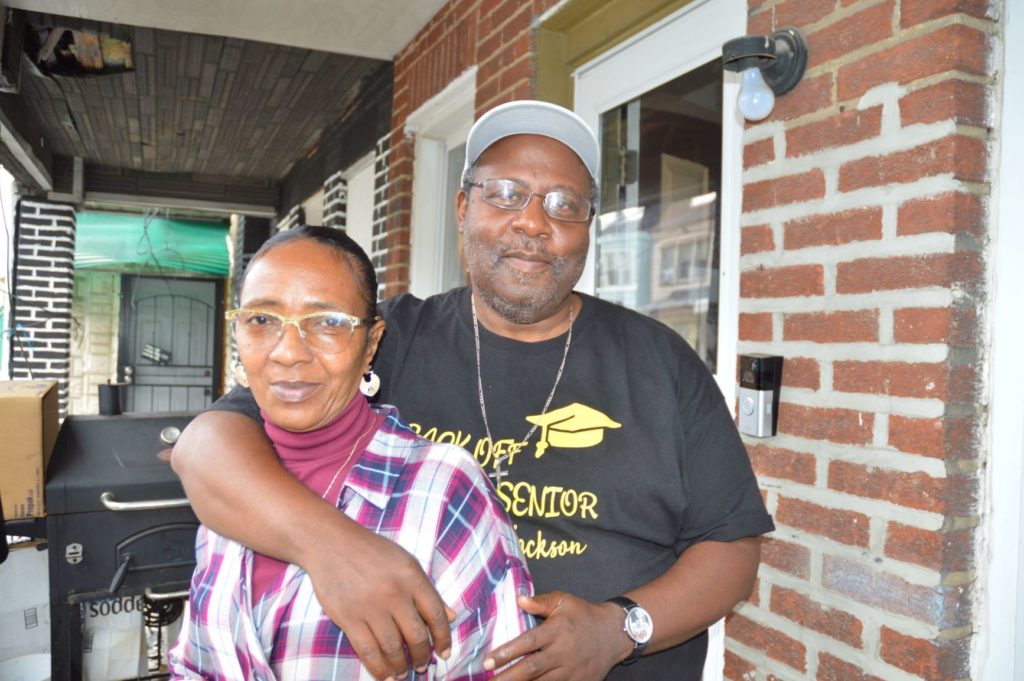
To Charlie Reeves, the most devastating fact was what he learned six months later, when the Environmental Integrity Project, working with NBC national news, revealed that air pollution monitors ringing the refinery had registered benzene – a known carcinogen – at the plant’s fence lines at concentrations averaging more than five times the federal limit (EPA’s “action level” for benzene) for an entire year. That meant that local residents like the Reeves family could have been exposed to excessive cancer risks for a long time – including months after the explosion, and potentially months or years before the fire.
Charlie is determined to use the new benzene air monitoring data collected by the Environmental Integrity Project to fight for environmental justice for his lower-income neighborhood. Southwest Philadelphia is one of 13 communities across the country that face potential cancer risks from excessive benzene air pollution detected at the fence lines of nearby oil refineries, according to EPA data produced for the first time in 2019 because of a lawsuit filed by the Environmental Integrity Project and allies to help protect communities in Texas, Louisiana, Pennsylvania and elsewhere. To hear Charlie tell his story, listen to our podcast about his life and battle with the oil refinery next door.


